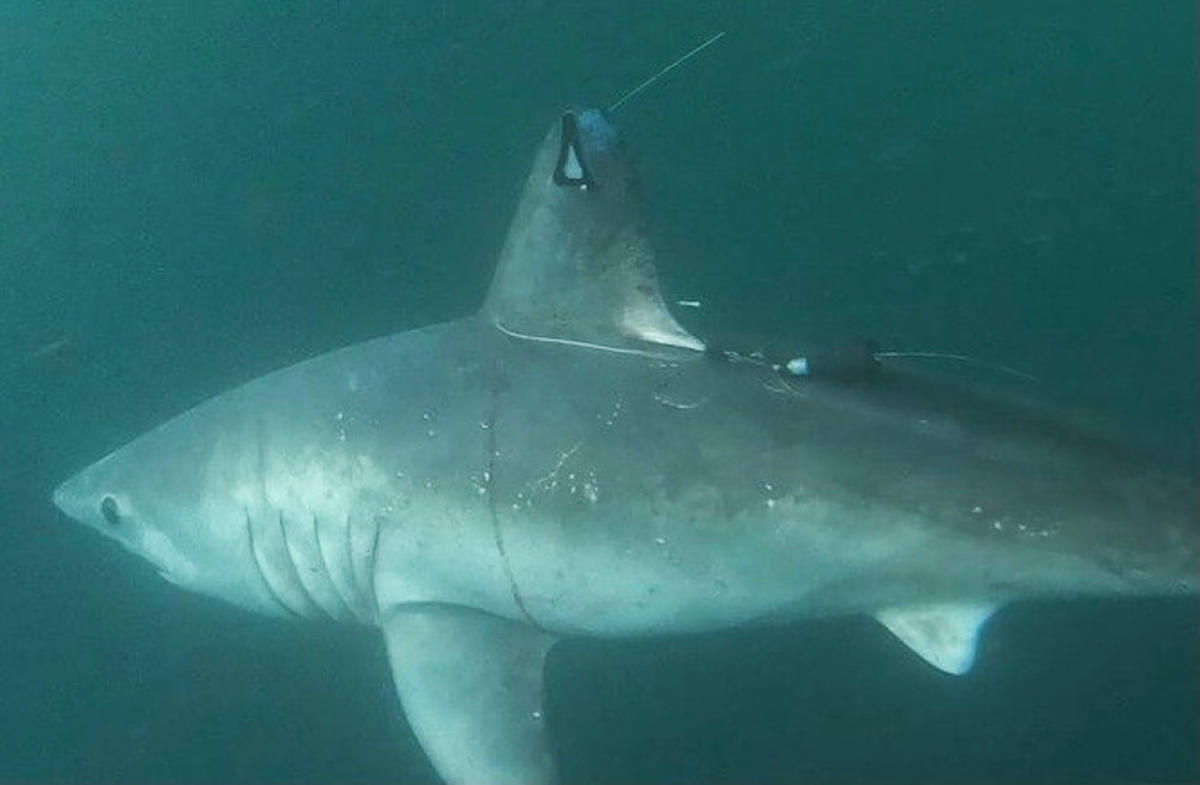Just weeks before a pregnant porbeagle shark was due to give birth, one of the two transmitters marine scientists had attached to the animal floated to the surface near Bermuda.
The team hadn’t expected the tag to turn up for months. They had only attached it to the 7-foot-long (2.13-meter) creature 158 days earlier, after hoisting the shark onto a boat off Cape Cod, Massachusetts, in October 2020 and giving it an ultrasound. The pop-off tag was designed to stay on for about a year.
“Something had gone terribly wrong,” said Brooke Anderson, then a shark researcher at Arizona State University.
A second tag, designed to send out a signal when the shark’s fin broke the water’s surface, would never transmit that signal again.
The data from the recovered “pop-off” tag showed a strange pattern. For about five months, the depth and temperature information seemed normal for the species. Then it all went wrong.
“Suddenly the temperature shot up, even at 600 meters, and stayed high,” Anderson said.
The creature’s diving pattern also became strange.
“All the data pointed to the same conclusion: she had been eaten,” Anderson said.
The researchers determined that the tag’s abnormal readings could be explained by the device having spent several days in the stomach of another animal.
Anderson and her fellow researchers presented their findings in a study published Tuesday morning in the journal Frontiers in Marine Science. It’s the first evidence that a porbeagle shark has been eaten by something even bigger.
The study authors listed a few possible killers. They narrowed down the suspects based on their biology. The tag’s temperature readings didn’t fit the profile of a mammal like a killer whale, for example. So the scientists focused on endothermic sharks, which have some warm-blooded capabilities.
“It had to be a shark that could raise its body temperature above the surrounding water. It had to be large enough to do enough damage to the porbeagle and it had to live in the area where the predation was occurring,” Anderson said.
The researchers concluded that a white shark or shortfin mako shark must have fed on their pregnant porbeagle and temporarily swallowed the tag.
“I think this was an adult female great white shark, probably over 15 feet long,” Anderson said.
Previously, researchers did not think it was possible for porbeagle sharks to serve as prey, she added.
The team’s original goal was to track pregnant porbeagle sharks throughout their pregnancy and find out where the animals typically go to give birth.
In total, they found and marked 11 porbeagle sharks over two seasons in the Atlantic Ocean. They hoisted them all into their boat, laid the animals on the deck, and gave the shark a hose with salt water dissolved in oxygen. They also covered its eyes with a wet towel.
“We operate like a NASCAR pit crew,” Anderson said. Eight of the sharks were pregnant.
Her team never imagined they would solve a deep-water murder mystery.
Matt Davis, a marine resources scientist for the Maine Department of Marine Resources who was not involved in the research, said the new study’s conclusion “certainly falls within the realm of credibility.”
The incident shows that scientists still have much to learn about life and the relationships between predators and prey in the mid-ocean depths, Davis added.
Porbeagle sharks are considered vulnerable by the International Union for Conservation of Nature because they have been overfished since the 1960s. According to Anderson, the species’ population had declined by 75% to 80% by 2001.
The species is making a comeback thanks to fishing regulations, but recovery will take decades, if not longer. Porbeagles can live 30 to 40 years in the Atlantic Ocean and have relatively few young compared to other species.
“We need to continue to tag and track these sharks to see how often this is happening,” Anderson said of the predation. “In one moment, this already depleted species not only lost a key reproductive female, but also all of her developing pups. We need to better understand how often this is happening and how much of an impact it can have on the population.”
In the Atlantic Ocean, where sharks are eating each other, their research could ultimately contribute to the recovery of the species.
This article was originally published on NBCNews.com
